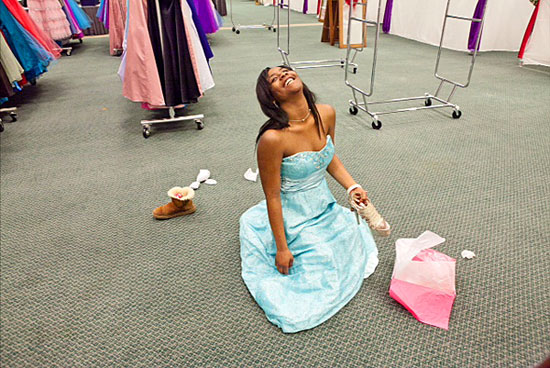A Cinderella moment
March 27, 2014

Foster teen Lisa Slayton gets a makeover at last year's Glamour Gown extravaganza. “It was like a blessing,” she says. “Fabulous.”
It was an invitation that another teenager might have taken for granted. Alexx Solyom had been asked to her first winter formal, a masquerade ball in January at Pasadena’s posh Brookside Country Club. It was her senior year. The entire Class of 2014 would be there.
“But I’d been in foster care for about two and a half years,” the 17-year-old said, “and I was living from foster placement to foster placement. I couldn’t afford a dress—I was in a group home and there weren’t enough funds.”
Enter Pam Bingham, the court-appointed special advocate for Alexx, who knew about a program just for girls in her situation. Within days, the teenager was heading home with a free, brand new, floor-length dress.
Their fairy godmother? Glamour Gowns, a collaboration between CASA of Los Angeles and hundreds of volunteers—many veterans of show business—who believe that girls in the foster care system should, like any girl, get to feel like Cinderella on prom night.
“It was a black and white dress, a long dress with crystals going around the front,” says Alexx, recalling how Bingham had kept it at her house in San Gabriel until the big night so it wouldn’t end up being damaged or vandalized in the group home.
“I felt like a princess.”
Now in its 13th year, Glamour Gowns is gearing up this week for its largest-ever Cinderella moment, an event that on Saturday will offer a free prom outfit and day of beauty to some 500 high school girls in foster care.
Initially launched by a handful of volunteers with a few dozen cast-off dresses, Glamour Gowns has since outfitted thousands of foster girls for proms, homecoming dances and winter formals. Its signature spring event, geared to prom season, has become such an annual extravaganza that the Los Angeles Convention Center now houses it.
Sponsors include: Chinese Laundry, which donates new shoes; Jenette Bras, which custom-fits each girl with appropriate foundation garments, and D.J. Bronson Inc., a Commerce-based apparel manufacturer that over the past five years has donated more than 5,000 new dresses—and, occasionally, tuxes—to grateful foster girls.
Meanwhile, members of I.A.T.S.E. Motion Picture Costumers Local 705, Costume Designers Guild Local 892 and Theatrical Wardrobe Union Local 768 donate their time, as do hair and makeup stylists.
“I know to some people it might sound frivolous, but it absolutely isn’t,” says Jennifer Parker-Stanton, a former costumer for film and TV who has been involved in nearly every Glamour Gowns event since its founding.
More than 28,000 children are under the jurisdiction of the dependency court in Los Angeles County and more than 17,000 live in foster care. Often, Parker-Stanton says, their caretakers can’t—or choose not to—afford “non-essential” yet emotionally important items like prom regalia. As a result, she says, girls in foster care often simply opt out of key adolescent milestones rather than risk more disappointment in a life that often is already painful.
“This is about self-esteem,” says Parker-Stanton, whose costuming work ranged from the TV series “Nash Bridges” to the Academy Award-winning “Million Dollar Baby”.
“The first time I did this, the girl I was working with looked in the mirror and said, ‘People say I’m pretty, but until now, I never thought so.’ And I thought, ‘All this time that I’ve spent running around, shopping for famous people, when you can change a life with just one dress.’”
“It’s a social experience that the girls never forget,” agrees Michael Williams, a veteran social worker with the Department of Children and Family Services who has seen at least five of his young clients transformed by the program. “Most of them have never gotten this kind of attention before. “
Anissa McNeil, a Glamour Gowns Committee member and CASA of Los Angeles board member, says the teenagers are often most surprised to see that the outfits are department store-quality merchandise, not hand-me-downs or seconds.
“They’re like, ‘You mean I get to keep this?’ And we say yes. ‘And it’s all new?’ Yes,” McNeil laughs. “One girl made me pinky promise one year that everything was free.”
McNeil says, the group makes sure no one leaves empty-handed.
“Last year, we had a plus-size young lady and she didn’t see any dresses she liked that were the right size, and you could just see her thinking, ‘Nothing ever works for me.’ She was saying, ‘Thanks for inviting me, I’ll just take a purse if that’s okay,’ when the seamstresses came in and…made a gown for her, right there on the spot. When she tried it on, and it fit like a glove, the look on her face—well, there wasn’t a dry eye in the house.”
McNeil says the event is particularly rewarding for her because she, too, spent time in foster care. “My mother had a nervous breakdown, and my brother and I became homeless when I was six,” she remembers. “Our grandmother raised us and became our legal guardian.”
Today, McNeil has a doctorate and a practice as an educational consultant, but remembers keenly the challenges that face foster children. She had to work two jobs in high school to pay for her prom dress, she says, and because she is over six feet tall, it had to be specially tailored. Then, on the big night, her date failed to show up.
“Hey, that’s what happens when you go for a playboy,” she recalls laughing. “But as my brother and I tell people, if you can overcome being homeless, you can overcome anything. I was determined to go, and I went by myself—in a gown that was long and blue and elegant.”
Posted 3/27/14













 405 bridge work causes a stink
405 bridge work causes a stink

